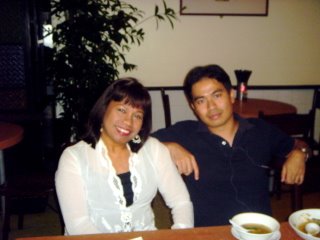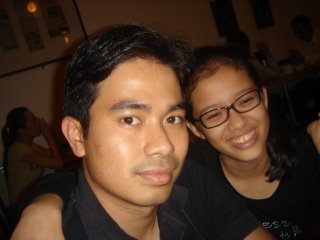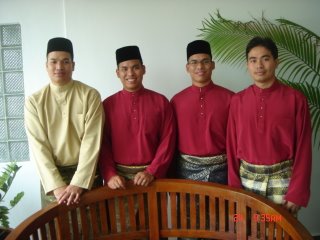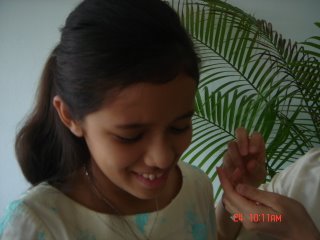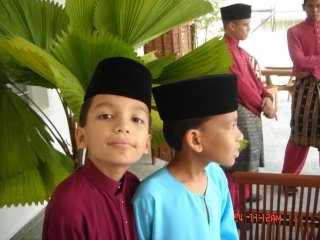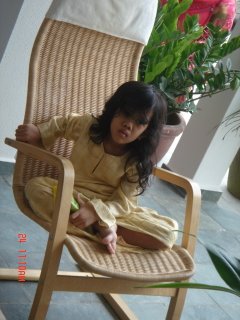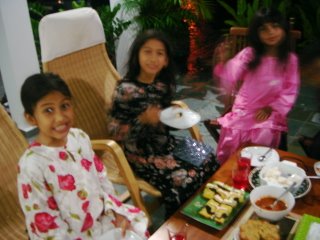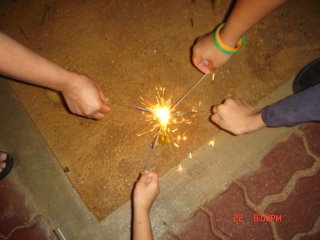I am honoured to have been mentioned in an article that my good friend, Daliah Merzaban wrote on martial arts and its intrinsic relationship to Islam. Thank you Daliah, it was an enjoyable process helping you in producing this article. The article can be found on Huffington Post here, and at Daliah's blog here.

Training at Shudokan Aikido Dojo, Seremban, Malaysia
Photo: Asma Faizal
A close friend introduced me to the idea that practicing martial arts has the potential to assist a Muslim in achieving a higher spiritual connection with God. Since I had always associated martial arts with Asiatic culture and Eastern religions such as Zen Buddhism, the connection with Islam did not immediately occur to me.
But after sitting in on one of my friend Imran’s Aikido and Karate classes at a dojo in the United Arab Emirates this month, the correlations began to unfold before my eyes. The mood was set when, just before starting two hours of rigorous and meticulous training, a number of students and the sensei assembled to pray Islam’s sunset prayer, known as maghrib.
Each technique they practised during the sessions that followed was precise, demanding mastery of the subtle movements of leg, arm, hand and back. Students of various backgrounds and faiths exhibited tremendous patience as they repeated these motions, striving to take any tiny step closer to precision of combat technique.

Basic Aikido movements. Shudokan Aikido Dojo, Malaysia
A close friend introduced me to the idea that practicing martial arts has the potential to assist a Muslim in achieving a higher spiritual connection with God. Since I had always associated martial arts with Asiatic culture and Eastern religions such as Zen Buddhism, the connection with Islam did not immediately occur to me.
But after sitting in on one of my friend Imran’s Aikido and Karate classes at a dojo in the United Arab Emirates this month, the correlations began to unfold before my eyes. The mood was set when, just before starting two hours of rigorous and meticulous training, a number of students and the sensei assembled to pray Islam’s sunset prayer, known as maghrib.
Each technique they practised during the sessions that followed was precise, demanding mastery of the subtle movements of leg, arm, hand and back. Students of various backgrounds and faiths exhibited tremendous patience as they repeated these motions, striving to take any tiny step closer to precision of combat technique.

Basic Aikido movements. Shudokan Aikido Dojo, Malaysia
Photo: Asma Faizal
Aikido, which originated in Japan, is typically done in pairs and practitioners learn to defend themselves while protecting their attackers from injury. Karate emphasises hard training and precise movement using a series of punches, kicks, and knee and elbow strikes.
While learning defensive fighting skills is the core purpose of training, interactions between students were remarkably cordial. A deep sense of equality filled the room; no matter how advanced in skill an apprentice, young or old, happened to be, s/he made an effort to enrich the experience of peers. Whether the belts they wore around their waists were black, brown, purple or white, everyone appeared to derive some value from the session.

Sensei Gerard Ratnam with Aikido student at Shudokan
Aikido, which originated in Japan, is typically done in pairs and practitioners learn to defend themselves while protecting their attackers from injury. Karate emphasises hard training and precise movement using a series of punches, kicks, and knee and elbow strikes.
While learning defensive fighting skills is the core purpose of training, interactions between students were remarkably cordial. A deep sense of equality filled the room; no matter how advanced in skill an apprentice, young or old, happened to be, s/he made an effort to enrich the experience of peers. Whether the belts they wore around their waists were black, brown, purple or white, everyone appeared to derive some value from the session.

Sensei Gerard Ratnam with Aikido student at Shudokan
Photo: Asma Faizal
This was inspiring for me because of the commonalities I saw with Islam. Muslims at varying stages along the spiritual path share a common ambition: to forge an intimate bond with the one Almighty God. Islam embodies an undeviating path to peace of mind, attained by aligning one’s physical, mental, financial, family and community affairs to this primary goal, which we should help each other work toward.
For a martial artist, the journey of perfecting technique doesn’t end with a black belt, it demands continual dedication and training, Imran told me later than evening. “Karate is like a pot of boiling water, and constant training is the fire that keeps the water boiling,” he said, citing wisdom from a prominent Karate instructor that can underlie both martial arts and Islamic devotion.
The comment brought to mind the concept of Al Insan Al Kamil in Islamic theology, describing the perfect being who has achieved unity with God in mind, body and soul. Attaining this level of consciousness demands a series of traits, such as steadfastness (istiqamah), self-inventory (muhasabah), improvement (tahsin) and humility – each honed to perfection.
Such traits are at the heart of martial arts as well, although a practitioner need not be driven, as Imran is, by a desire to please God. There are, furthermore, a few martial arts practices that go against sharia which, for instance, discourages blows to the face and bowing to other human beings.

Sitting in seiza. Shudokan Aikido Dojo, Malaysia
This was inspiring for me because of the commonalities I saw with Islam. Muslims at varying stages along the spiritual path share a common ambition: to forge an intimate bond with the one Almighty God. Islam embodies an undeviating path to peace of mind, attained by aligning one’s physical, mental, financial, family and community affairs to this primary goal, which we should help each other work toward.
For a martial artist, the journey of perfecting technique doesn’t end with a black belt, it demands continual dedication and training, Imran told me later than evening. “Karate is like a pot of boiling water, and constant training is the fire that keeps the water boiling,” he said, citing wisdom from a prominent Karate instructor that can underlie both martial arts and Islamic devotion.
The comment brought to mind the concept of Al Insan Al Kamil in Islamic theology, describing the perfect being who has achieved unity with God in mind, body and soul. Attaining this level of consciousness demands a series of traits, such as steadfastness (istiqamah), self-inventory (muhasabah), improvement (tahsin) and humility – each honed to perfection.
Such traits are at the heart of martial arts as well, although a practitioner need not be driven, as Imran is, by a desire to please God. There are, furthermore, a few martial arts practices that go against sharia which, for instance, discourages blows to the face and bowing to other human beings.

Sitting in seiza. Shudokan Aikido Dojo, Malaysia
Photo: Asma Faizal
To bridge gaps inherent in some martial art forms and supplement his training, Imran added an exercise technique known as Senaman Tua, native to his homeland Malaysia, to his martial arts regimen. Most-easily understood as an Islamic form of yoga, Senaman Tua requires that in addition to physical development, students take a journey toward self-realisation.
One who trains in Senaman Tua will eventually have all the core skills to learn and master Silat, a martial art practised in Malaysia and Indonesia, rooted in Islam. The goal of each Silat practitioner is to improve their art for the sake of God, explained Mohd Nadzrin bin Abdul Wahab, Imran’s Senaman Tua instructor, who has offered Silat training in Malaysia since 2003.

Sensei Thamby Rajah, father of Malaysian Aikido, instructing me on the finer points of Ikkajo
To bridge gaps inherent in some martial art forms and supplement his training, Imran added an exercise technique known as Senaman Tua, native to his homeland Malaysia, to his martial arts regimen. Most-easily understood as an Islamic form of yoga, Senaman Tua requires that in addition to physical development, students take a journey toward self-realisation.
One who trains in Senaman Tua will eventually have all the core skills to learn and master Silat, a martial art practised in Malaysia and Indonesia, rooted in Islam. The goal of each Silat practitioner is to improve their art for the sake of God, explained Mohd Nadzrin bin Abdul Wahab, Imran’s Senaman Tua instructor, who has offered Silat training in Malaysia since 2003.

Sensei Thamby Rajah, father of Malaysian Aikido, instructing me on the finer points of Ikkajo
Photo: Asma Faizal
“The basic idea behind silat is softness is strength,” said Nadzrin, 34. Based in Kuala Lumpur, Nadzrin was drawn into Silat after seeing how Islam was woven into each lesson of his first guru, Muhammad Radzi Haji Hanafi. “Every other word” he uttered was an Islamic principle, related Nadzrin.
Silat teaches practitioners that they should dedicate their whole self, mind, body and soul to the intention of performing the art for the sake of God in order for the goal to be worthwhile. Apprentices should strive to be truthful, keep promises, and act with strong conviction without disrespecting their parents and teachers.
“Every martial technique depends on a preset, pre-thought movement of the human body,” explained Nadzrin, who has written extensively on Silat on a series of blogs. “A possible stumbling block to spiritual development is the practitioner's ascribing of his development or prowess to himself ... Thus, we are taught in Silat that all gerak(movement) belongs to Allah, The Mover, in every sense of the word.”

Children at play, Shudokan Aikido Dojo, Malaysia
“The basic idea behind silat is softness is strength,” said Nadzrin, 34. Based in Kuala Lumpur, Nadzrin was drawn into Silat after seeing how Islam was woven into each lesson of his first guru, Muhammad Radzi Haji Hanafi. “Every other word” he uttered was an Islamic principle, related Nadzrin.
Silat teaches practitioners that they should dedicate their whole self, mind, body and soul to the intention of performing the art for the sake of God in order for the goal to be worthwhile. Apprentices should strive to be truthful, keep promises, and act with strong conviction without disrespecting their parents and teachers.
“Every martial technique depends on a preset, pre-thought movement of the human body,” explained Nadzrin, who has written extensively on Silat on a series of blogs. “A possible stumbling block to spiritual development is the practitioner's ascribing of his development or prowess to himself ... Thus, we are taught in Silat that all gerak(movement) belongs to Allah, The Mover, in every sense of the word.”

Children at play, Shudokan Aikido Dojo, Malaysia
Photo: Asma Faizal
While certain varieties of Silat became controversial because they deviated from Islam, most Silat styles in Malaysia are sharia-compliant, he said. Some schools, meanwhile, have modified techniques used in other martial arts like Aikido and Taekwondo to ensure they comply with Islam by, for instance, including bows that do not reach the level of sujud, prostration in Islamic prayer. Silat and Senaman Tua styles are now offered in many countries, including the United States, Europe, South Africa, Canada and Singapore.
Yet Silat on its own is no replacement for a Muslim’s intellectual training in religion. It is rare to find instructors who are also qualified religious scholars, which had been commonplace between the 11th-19th centuries, Nadzrin said.
“I have discovered that the only way to learn Islam is to learn Islam directly, not going through the goggles of a martial art. Some martial arts teachers aren’t qualified to teach or misrepresent it. However, in martial arts, you get to see the practice of Islam in muamalat (interactions),” he said.
Islam, Arabic for ‘submission to God’, embodies an entire lifestyle whereby followers integrate acts of worship into everything they do, such that expressions of gratitude to God become the goal of each activity, even beyond the five daily prayers.
In the area of fitness, we are encouraged to live in a healthy, beneficial way, consistently keeping our egos and impulses in check. In one Hadith, Prophet Muhammad, peace be upon him, advised Muslims: "Teach your children swimming, archery and horse-riding”.

International students gather for Karate seminar in Kerala, India
While certain varieties of Silat became controversial because they deviated from Islam, most Silat styles in Malaysia are sharia-compliant, he said. Some schools, meanwhile, have modified techniques used in other martial arts like Aikido and Taekwondo to ensure they comply with Islam by, for instance, including bows that do not reach the level of sujud, prostration in Islamic prayer. Silat and Senaman Tua styles are now offered in many countries, including the United States, Europe, South Africa, Canada and Singapore.
Yet Silat on its own is no replacement for a Muslim’s intellectual training in religion. It is rare to find instructors who are also qualified religious scholars, which had been commonplace between the 11th-19th centuries, Nadzrin said.
“I have discovered that the only way to learn Islam is to learn Islam directly, not going through the goggles of a martial art. Some martial arts teachers aren’t qualified to teach or misrepresent it. However, in martial arts, you get to see the practice of Islam in muamalat (interactions),” he said.
Islam, Arabic for ‘submission to God’, embodies an entire lifestyle whereby followers integrate acts of worship into everything they do, such that expressions of gratitude to God become the goal of each activity, even beyond the five daily prayers.
In the area of fitness, we are encouraged to live in a healthy, beneficial way, consistently keeping our egos and impulses in check. In one Hadith, Prophet Muhammad, peace be upon him, advised Muslims: "Teach your children swimming, archery and horse-riding”.

International students gather for Karate seminar in Kerala, India
Photo: Asma Faizal
Martial arts help people attain these goals, according to Nadzrin, because with proper training they encourage alignment and coordination between mind and body. He said participants gain many benefits, including equilibrium, muscular strength, stamina, cardiovascular maintenance, hormonal balance, improved kinesthesis and their senses become more receptive.
When a Muslim’s body is healthy and fit, s/he is better equipped to, for instance, apply greater focus in prayer. In this context, one’s pursuit of fitness is not driven by a desire to feed one’s vanity and ego by attaining a toned figure or buff muscles, but rather to strengthen one’s body to be better able to practise faith.
Reflecting back to Imran’s training, I am impressed at how the mastery of combat techniques actually moves martial artists away from negative energies like anger and closer to the serenity inherent to the Islamic state of mind.
“Martial arts teach us awareness,” said Imran. “The more we train, the more aware we become. The more aware we become, the less likely we would get involved in a situation of conflict. So ironically, the more we train, the less use we will have for our violent techniques. We attain peace.”

Me training at Shudokan Aikido Dojo, Seremban, Malaysia
Martial arts help people attain these goals, according to Nadzrin, because with proper training they encourage alignment and coordination between mind and body. He said participants gain many benefits, including equilibrium, muscular strength, stamina, cardiovascular maintenance, hormonal balance, improved kinesthesis and their senses become more receptive.
When a Muslim’s body is healthy and fit, s/he is better equipped to, for instance, apply greater focus in prayer. In this context, one’s pursuit of fitness is not driven by a desire to feed one’s vanity and ego by attaining a toned figure or buff muscles, but rather to strengthen one’s body to be better able to practise faith.
Reflecting back to Imran’s training, I am impressed at how the mastery of combat techniques actually moves martial artists away from negative energies like anger and closer to the serenity inherent to the Islamic state of mind.
“Martial arts teach us awareness,” said Imran. “The more we train, the more aware we become. The more aware we become, the less likely we would get involved in a situation of conflict. So ironically, the more we train, the less use we will have for our violent techniques. We attain peace.”

Me training at Shudokan Aikido Dojo, Seremban, Malaysia
Photo: Asma Faizal
*Special thank you to my wonderfully patient wife Asma Faizal for sharing photographs for this piece.
*Special thank you to my wonderfully patient wife Asma Faizal for sharing photographs for this piece.


























